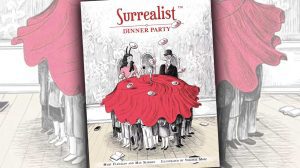Disclosure: Meeple Mountain received a free copy of this product in exchange for an honest, unbiased review. This review is not intended to be an endorsement.
I imagine design teams the world over work very hard to determine how you will feel the second time you play a cooperative game. Oh sure, they must pour themselves into first impressions, everything from the communication of the box, the first crack of the shrink, the setup, the rulebook, and the introductory experience. But all of that leads up to the second play, because it’s the second play in which the rabble come to the table with a genuine taste of what they’re up against.
That second visit might be marked by the despair of a swiftly brutal first defeat. It might be enthused by the heart-wrenching, final-turn loss that let loose a sliver of hope for the next experience. Perhaps the second visit is primed by the unexpected joy of memorably snatching victory from the jaws of defeat. Or perhaps the second visit comes on the heels of so decisive a victory that the players are already beginning to wonder if they’ve vidi-ed and vici-ed all the game has to offer.
Whether you’re playing Spirit Island, Ghost Stories (or Last Bastion), Horrified, Immune (a little-known gem), Sub Terra (or Sub Terra II), or The A.R.T. Project, you’ve known an experience somewhere on this continuum.
But there is a class of cooperative game that swims contentedly in the shallow end of the pool—the family co-op. These games live in the realm of the seen and conquered, and yet they continue to have appeal by virtue of their playfulness and their approachability. Some accomplish this via their thoughtful-but-never-deadly style, like Matt Leacock’s Forbidden series (check out our reviews of Forbidden Jungle and Forbidden Desert) and Antoine Bauza’s Kraken Attack. Others live here by virtue of their shifting challenges, stickers, and expanding rulesets, like Zombie Kidz Evolution and Miller Zoo.
Miller Zoo is a real place in Quebec. Miller Zoo, the board game, is a glimpse into the mission of that place: rescue and care for animals. Provide for enough needs, welcome enough critters, and emerge victorious. Fail, and, well, I’m not sure what it’s like to fail just yet.
It’s zoo easy
MIller Zoo takes place over a series of days. Players begin with four resource cards that double as fare for movement to one of the zoo’s seven spaces. Crisis cards introduce the needs of certain animals: combs, balls, apples, medkits, or tools, each of which are marked by a token.
The bulk of a day is spent conversing over the best sequence to spend cards. Visiting the three habitat spaces allows for meeting animal needs, while visiting the four reception spaces involves contributing resources to welcome new animals to the habitats. When an animal’s needs are met, players can accompany the new tenant to its habitat for free, opening the door to efficient combos. Otherwise, each movement costs a card.

At the end of the day, unmet needs become crises that must be dealt with by drawing the top of the deck until a matching icon emerges. This is generally a bad idea and should be avoided. Up to three cards may be saved for community use in future rounds, while the rest are discarded. Then it’s time for another day.
If players can receive all seven animals, completing the round without exhausting the resource deck, it’s time to do the victory dance. If the deck runs out, it’s time to pack up and try again.

It’s zoo challenging
Five particular victories, sprung from five particular challenges, will open five envelopes that beef up the zoo. Since the primary objective is receiving animals, there are obviously more animals waiting in the wings. The six character cards bear markings curiously shaped like stickers. Likewise, there are blanks throughout the rulebooks tagged and outlined and waiting for new information. The game grows in wholly expected ways.

There is also an envelope awaiting that first loss. If it weren’t for the fact that I have a review to write, I wouldn’t know the contents of that envelope. I cheated—I peeked, only to discover what I already suspected. I see no need to spoil the thing. Let’s just say the contents make sense and might come in handy the longer you spend with this animal collective.
Where Miller Zoo becomes a game of lasting interest is in the gallery of specific challenges that pop up over time. If you’ve played Zombie Kidz Evolution (or any of the LEGO video games), you know what it’s like to chase specific thresholds of easter-egg quality in the name of acquiring stickers and accolades due to an overzealous completionist ideology. It’s a perfectly human endeavor.
It’s zoo inviting
In an online comment, the design team mentioned their desire that Miller Zoo be particularly accommodating to folks less entrenched in the hobby. Getting specific, they spoke of a 50% target success rate among families who don’t play many board games.
Mission accomplished. Miller Zoo is suuuper easy in its primary progression. The early games introduce new trials and corresponding gifts to approach every task. One half-dozen games later, most families will have a solid introduction to cooperative play, early victories, stickered goodness, and a delightful thematic setting. Then those oddly specific challenges begin. I say again, mission accomplished. Thomas Dagenais-Lespérance (Decrypto) has built a cozy little game.
If you’re looking for the next Spirit Island, move along, there’s nothing to see here. Regarding complexity, I would put the zoo a step below Toy Story: Obstacles & Adventures. The gameplay script is the same—the quintessential co-op—but without the Pixar world and deck-building. The shared deck, doled out four (or more) cards at a time, creates a wholly straightforward decision space and a breezy mood. My six- and ten-year-old clamor for these types of experiences, and they can capably play without me. My teens can jump into the easy learning curve for a half-hour with the fam. I think non-gaming grandparents can weather the learning curve, too. Call it a bonding project for the generations.
The one mechanic that keeps Miller Zoo lively is the crisis at dusk. When there are tokens remaining, it’s entirely possible to shed six or ten cards making animals happy before bedtime. Some plays push the deck to its limit with the friendliest of tensions. I appreciate that the mechanics introduce a hint of urgency to the otherwise reserved tone.

To make matters clear: you’ll not find a single boot-print treading new ground in Miller Zoo. Instead, you’ll find a basic, heart-warming narrative to mirror an episode of Disney’s Animal Kingdom with a set of highly approachable rules. You’ll find simplicity and a few interesting challenges. In fewer than a dozen plays, you’ll have opened everything and you’ll know how far you intend to pursue those completionist aims. If you peel a single sticker, you won’t be able to trade or sell it; but the game is infinitely playable if you find it to be in your wheelhouse.
Miller Zoo doesn’t pretend to be anything more. I rate the game highly because it lives comfortably in its skin for the right crowd. In fact, it’s exactly the sort of title you hope families take home from the zoo’s gift shop because it’s well designed, they’ll enjoy their memories, and they might find they like cooperative play. It’s a solid value, especially for families who love animals. My daughter has asked for it every day since she tried it. Something tells me when we do eventually lose, she’ll just want to try it again.











Add Comment